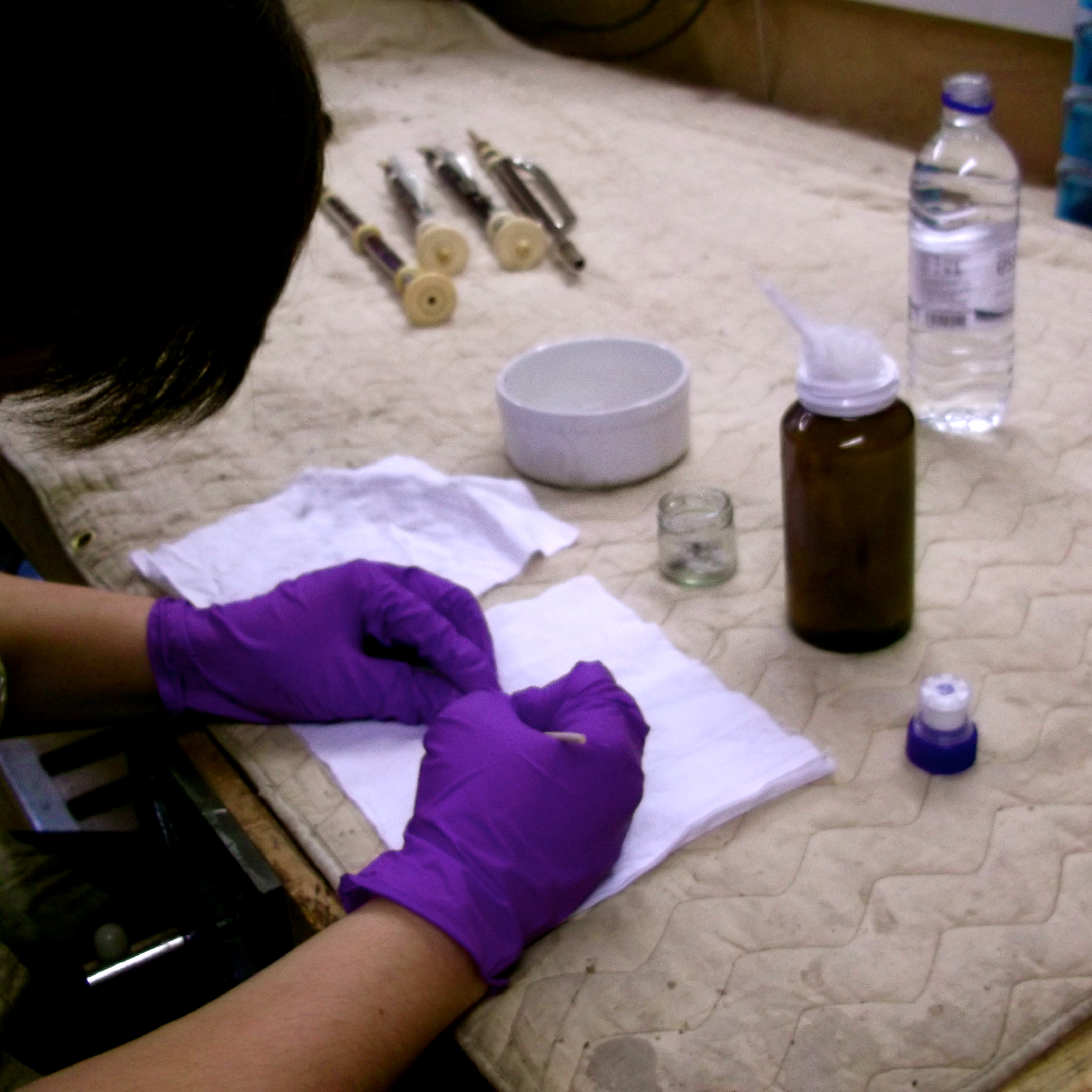Guest post from Olivia Thorne, a museums placement student at St Cecilia’s Hall
As a classically-trained cellist, the image that springs to mind for me when I hear the word ‘fiddle’ is a violin used by folk musicians to play jigs and reels. However, as I discovered during my internship at St Cecilia’s Hall, the fiddle family encompasses so much more. Organologists (that’s musical instrument specialists) use the term ‘fiddle’ to refer to any string instrument played with a bow. The more formal classification ‘bowed lute’ also applies to this class of instrument. Fiddles can be played held under the chin like a violin, held upright and rested on the knee, or played standing, propped on a spike. A wide variety of materials are used to make fiddles, from coconut shell to snakeskin to maple, ebony and ivory, and instrument designs vary from the simple to extremely complicated. Fiddles are a worldwide phenomenon, with most cultures possessing their own variation on the instrument, and fiddle-playing traditions connect groups of people from different corners of the globe. Over the course of this blog post, I will highlight some of the wacky and wonderful fiddles in the collection at St Cecilia’s Hall, and share some of the surprises that emerged during my research with these instruments. The examples discussed also reveal some insights into the process of identifying musical instruments, and the ongoing collection research which goes on behind the scenes in any museum.

One-string fiddle
A circus runaway – the mysterious case of the one-string fiddle
When I first unwrapped this instrument from storage, I was confronted with an enigma. What was this instrument? It seemed to be a chimaera of the string instrument world, borrowing elements from lots of different instruments to make one very unusual fiddle. The top half is shaped like a violin, with a wide, rounded lower half which more closely resembles a 19th-century guitar. The soundholes are in a shape commonly seen on the viola d’amore – a member of the viol family popular in the 17th and 18th centuries. The very long neck and single string presented even more of a mystery. Single-string bowed instruments are rare worldwide, and even more so in the Western classical tradition to which the violin and viol family belong. However, string instruments have been the subject of experimentation for centuries, and the form of even the violin continues to evolve. Could this be an example of experimental innovation? Little information was collected about this instrument when it entered the museum’s collection in 1982. Luckily, the National Music Museum in South Dakota holds a perfect match within their collection. Documentation from the NMM revealed this to be a ‘violon du cirque’ – a circus violin – made in France c. 1900. This explains the motivation behind the maker’s experimental design – creating an instrument with a high novelty, entertainment and humour factor. The details of the circus routines in which this highly unusual fiddle might have played a part can only be imagined!
Looks can be deceiving

Złóbcoki

Baton-shaped kit
At first glance, this narrow-bodied instrument resembles a kit – a miniature fiddle popular as a portable instrument for private dancing tutors during the 17th and 18th centuries. Kits come in two basic categories – those shaped like miniature violins and those with long narrow bodies described as ‘baton-shaped’ by some authors and ‘gondola-shaped’ by others. However, this example is too large to be a kit, and doesn’t quite conform to the usual shape of the baton-style version. In fact, this is a złóbcoki, and has a completely different cultural context to the kit. While you would find a kit at home in the refined drawing rooms of London polite society in the 18th century, the złóbcoki is the folk fiddle of the Górale people of the Tatra Mountains in Poland. The złóbcoki was traditionally played at celebrations, weddings and marches, alongside a drum or basy (a Polish bass fiddle broadly comparable to the cello), and sometimes local bagpipes. This example demonstrates that within the twisting family tree of musical instruments, two instruments with very similar forms may have very different cultural contexts. However, the baton-shaped kit is thought to have evolved as a modification of the older rebec, a bowed instrument played widely in Europe during the Medieval and Renaissance eras. It is possible that future research may reveal that both the złóbcoki and the kit have their origins in the rebec – however without further data we can only speculate.
An imposter amongst the fiddles – identifying a Tibetan lute

Sgra-snyan
To tell the global story of music, musical instrument museums often collect examples from around the world. This means that organologists sometimes need to identify instruments from cultures other than their own, which can be confusing work. This striking red string instrument is carved from a single piece of wood, with a round resonator covered in hide which amplifies the sound of the strings. It was previously identified in museum records from the 1990s as a pi-wang, a type of bowed string instrument from Tibet. However, after a little research it became clear that this instrument did not have the cylindrical sound box of a pi-wang, and also had more than the standard two strings. Utilising the power of the internet, which makes finding reference images a breeze, I determined that it was definitely the wrong shape to be a pi-wang. After some further reading, another possible candidate emerged – the Himalayan plucked instrument called sgra-snyan (the name means ‘pleasant sound’). Traditionally, one of the roles of the sgra-snyan was to accompany nang-ma songs, associated with the music of the Dalai Lama’s court in the Tibetan city of Lhasa. Today, ensembles featuring the sgra-snyan along with the pi-wang and traditional flutes are played by the Tibetan community in exile in Bhutan and India, where the nang-ma repertory has been revived. Having revealed its true identity, this particular instrument can no longer be considered a fiddle. However, this example goes to show how the abundance of reference images and information on the internet has changed the task of musical instrument research between the 1990s and today. Understanding a museum collection is an ongoing process – there is always more to learn!
The varieties of fiddle held in the collection at St Cecilia’s Hall are far too numerous to research in a four-week internship, or cover in a single blog post. To explore more of the fascinating world of fiddles, visit the Laigh Hall or the Wolfson Gallery at the newly redeveloped museum.

Olivia Thorne
Further Reading
Cooley, T 1997, Ethnography, Tourism and Music-culture in the Tatra Mountains: Negotiated Representations of Polish Gorale Ethnicity, Doctoral Thesis submitted to Brown University, Rhode Island, accessed via ProQuest.
Durkin, R 2017, ‘The Dancing-Master’s Toolkit: a summary of the pochette of the seventeenth and eighteenth centuries and its role in society’, The Galpin Society Journal, no. LXX, pp. 65-79.
Halfpenny, E and Grame, TC 2017, ‘Stringed instrument’, Encyclopaedia Britannica Online, viewed 13th July 2017, accessible at <https://www.britannica.com/art/stringed-instrument#toc53709>.
Helffer, M 2000, ‘Tibetan Culture in South Asia’, in A. Arnold (ed.), The Garland Encyclopedia of World Music, Vol. 9, Garland, New York and London.
Henrion-Dourcy, I and Dhondup, T 2017, ‘Instruments – Tibetan Music’, in Grove Music Online, viewed 11th July 2017, accessible via Oxford Music Online.
Remnant, M 1984, ‘Kit’, in Grove Music online, viewed 13th July 2017, accessible via Oxford Music Online.
Stęszewski, J 2017, ‘Instruments – Poland’, in Grove Music Online, viewed 10th July 2017, accessible via Oxford Music Online.






 What has made this internship most special, though, is all the odd jobs that I have ended up doing, whether that be sorting through the odd folder of the Langwill-Waterhouse Archive; conserving tarnished bagpipes for an upcoming symposium; or learning about the proper care of instruments as part of the relocation of EUCHMI’s collection to improved storage facilities. In the process, I have learned about instruments I never knew existed, gained archive management and conservation experience, and polished up my research skills into the bargain.
What has made this internship most special, though, is all the odd jobs that I have ended up doing, whether that be sorting through the odd folder of the Langwill-Waterhouse Archive; conserving tarnished bagpipes for an upcoming symposium; or learning about the proper care of instruments as part of the relocation of EUCHMI’s collection to improved storage facilities. In the process, I have learned about instruments I never knew existed, gained archive management and conservation experience, and polished up my research skills into the bargain.